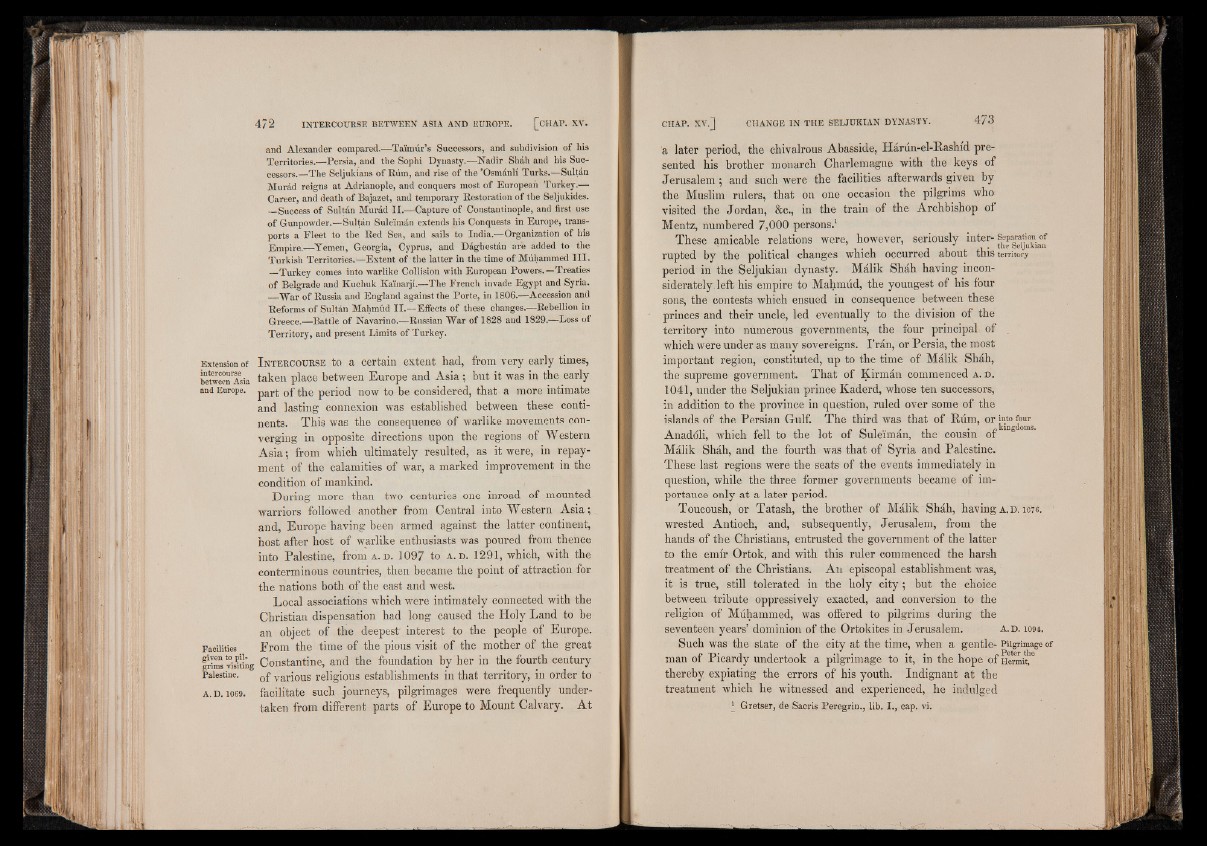
Extension of
intercourse
between Asia
and Europe.
Facilities
given to pilgrims
visiting
Palestine.
A. D. 1069.
and Alexander compared.—Taimúr’s Successors, and subdivision of his
Territories.—Persia, and the Sophi Dynasty.—Nadir Sháh and his Successors.—
The Seljukians of Rúm, and rise of the ’Osmánlí Turks.—Sultán
Murad reigns at Adrianople, and conquers most of European Turkey.—
Career, and death of Bajazet, and temporary Restoration of the Seijukides.
—Success of Sultán Murad I I .—Capture of Constantinople, and first use
of Gunpowder.—Sultán Sule'imán extends his Conquests in Europe, transports
a Fleet to the Red Sea, and sails to India.—Organization of his
Empire.—Yemen, Georgia, Cyprus, and Dághestán aré added to the
Turkish Territories.—Extent of the latter in the time of Múhammed I I I .
—Turkey comes into warlike Collision with European Powers.—Treaties
of Belgrade and Kuchuk Ka'inarji.—The French invade Egypt and Syria.
—War of Russia and England against the Porte, in 1806.—Accession and
Reforms of Sultán Mahmud I I .—Effects of these changes.—Rebellion in
Greece.—Battle of Navarino.—Russian War of 1828 and 1829.—Loss of
Territory, and present Limits of Turkey.
I n t e r c o u r s e to a certain extent had, from very early times,
taken place between Europe and Asia ; but it was in the early
part of the period now to be considered, that a more intimate
and lasting connexion was established between these continents.
This was the consequence of warlike movements converging
in opposite directions upon the regions of Western
Asia; from which ultimately resulted, as it were, in repayment
of the calamities of war, a marked improvement in the
condition of mankind.
During more than two centuries one inroad of mounted
warriors followed another from Central into Western Asia;
and, Europe having been armed against the latter continent,
host after host of warlike enthusiasts was poured from thence
into Palestine, from a . d . 1097 to a . d . 1291, which, with the
conterminous countries, then became the point of attraction for
the nations both of the east and west.
Local associations which were intimately connected with the
Christian dispensation had long caused the Holy Land to be
an object of the deepest' interest to the people of Europe.
Erom the time of the pious visit of the mother of the great
Constantine, and the foundation by her in the fourth century
of various religious establishments in that territory, in order to
facilitate such journeys, pilgrimages were frequently undertaken
from different parts of Europe to Mount Calvary. At
a later period, the chivalrous Abasside, Harun-el-Rashid presented
his brother monarch Charlemagne with the keys of
Jerusalem; and such were the facilities afterwards given by
the Muslim rulers, that on one occasion the pilgrims who
visited the Jordan, &c., in the train of the Archbishop of
Mentz, numbered 7,000 persons.1
These amicable relations were, however, seriously inter- ^
rupted by the political changes which occurred about this territory
period in the Seljukian dynasty. Malik Shah having inconsiderately
left his empire to Mahmud, the youngest of his four
sons, the contests which ensued in consequence between these
princes and their uncle, led eventually to the division of the
territory into numerous governments, the four principal of .
which were under as many sovereigns. I’ran, or Persia, the most
important region, constituted, up to the time of Malik Shah,
the supreme government. That of Kirman commenced a . d .
1041, under the Seljukian prince Kaderd, whose ten successors,
in addition to the province in question, ruled over some of the
islands of the Persian Gulf. The third was that of Rum, or into four
Anadoli, which fell to the lot of Suleiman, the cousin of
Malik Shah, and the fourth was that of Syria and Palestine.
These last regions were the seats of the events immediately in
question, while the three former governments became of importance
only at a later period.
Toucoush, or Tatash, the brother of Malik Shah, having a . d . io76. ’
wrested Antioch, and, subsequently, Jerusalem, from the
hands of the Christians, entrusted the government of the latter
to the emir Ortok, and with this ruler commenced the harsh
treatment of the Christians. An episcopal establishment was,
it is true, still tolerated in the holy c ity ; but the choice
between tribute oppressively exacted, and conversion to the
religion of Muhammed, was offered to pilgrims during the
seventeen years’ dominion of the Ortokites in Jerusalem. a . d . 1094.
Such was the state of the city at the time, when a gentle- Pilgrimage of
man of Picardy undertook a pilgrimage to it, in the hope of Hermit,
thereby expiating the errors of his youth. Indignant at the
treatment which he witnessed and experienced, he indulged
1 Gretser, de Sacris Peregrin., lib . I., cap. vi.